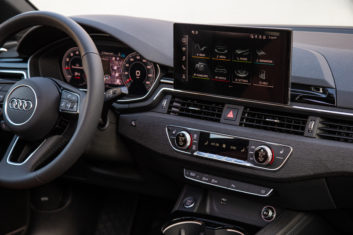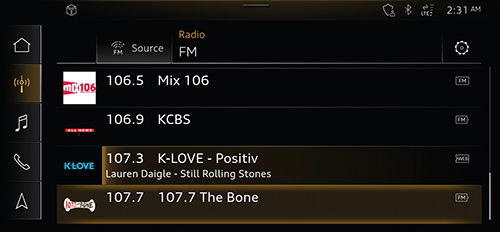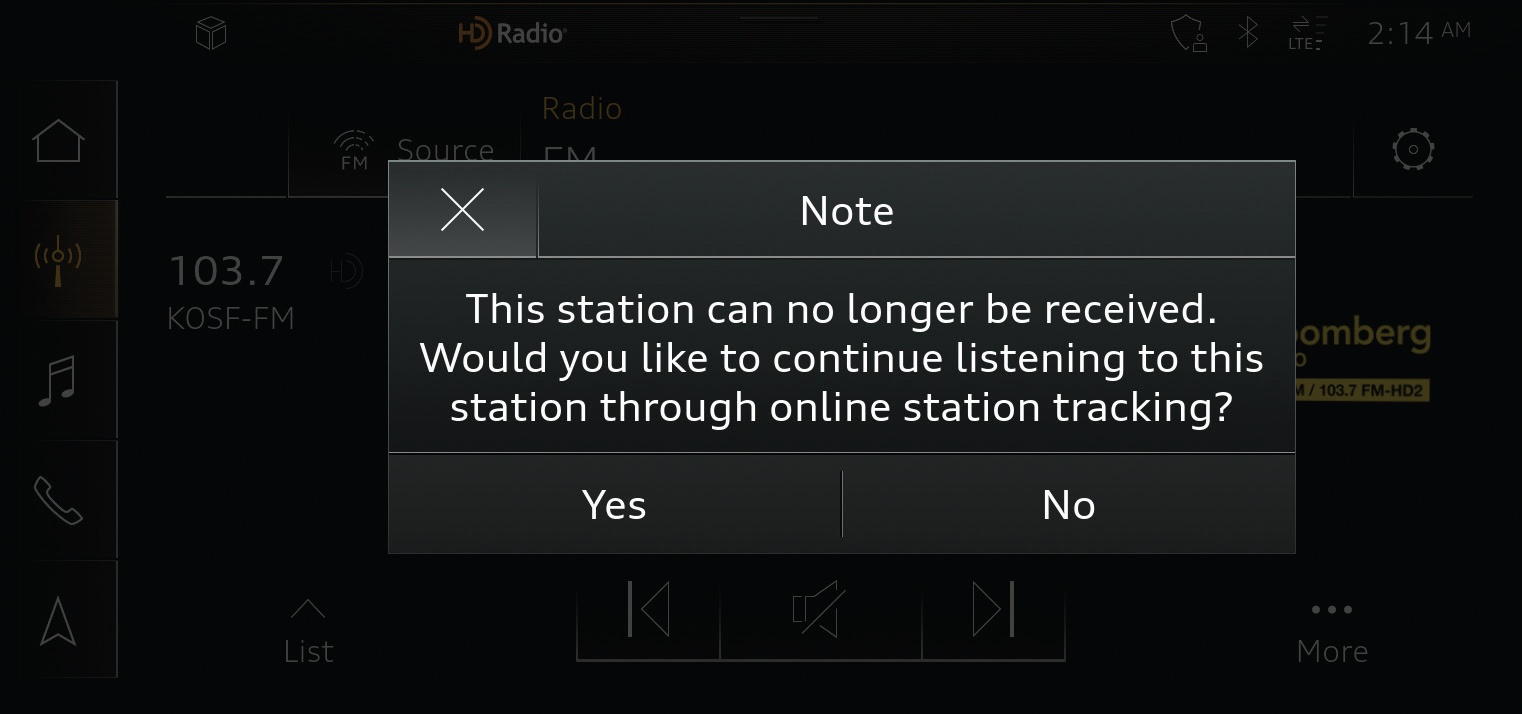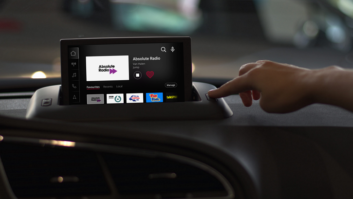
The coronavirus will not delay arrival of more hybrid radio receivers in the United States. Car manufacturer Audi says it will offer the new infotainment technology — capable of receiving terrestrial analog and HD Radio signals blended with streaming audio — in new cars set to arrive at dealerships in the coming months.
In addition, Audi will support the hybrid system from SiriusXM called 360L in 10 of its 2021 model year vehicles. Dodge Ram was the first to offer 360L in a 2019 model; and GM announced in December that it planned to bring 360L to a million cars in 2020. But Audi is believed to be the only system with hybrid radio capability that supports terrestrial FM radio as well.
Open Standard
Hybrid radio combines one-way “over-the-air” terrestrial or satellite radio reception with two-day online connectivity and streaming content, to create a new kind of platform in connected cars.

The hybrid functionality was announced by Audi of America as part of its Generation 3 infotainment technologies expected to arrive in most 2021 Audi vehicles this fall. Here is how Audi described hybrid digital radio functionality in that announcement: “For terrestrial FM or HD FM radio listeners on the go, hybrid digital radio allows them to continue listening to the same channel even after driving outside of the channel’s range. Either automatically or by request, once the hybrid radio senses a weak radio signal, it will switch to the online, digital version of the same channel. Conversely, the channel will switch back from a digital to a radio signal when it senses better reception.Upon cycling a vehicle off and on again, the digital radio station will continue to play.”
The spread of hybrid capabilities could set up a critical period of preparation by U.S. broadcasters, according to radio industry observers, as a wider rollout of the new technology gains footing.

Several technology companies are trying to establish themselves in the hybrid radio marketplace in the United States and abroad. DTS Connected Radio, Radioline, Radioplayer and even Audi are “in some ways competing with each other, and in other ways working together,” according to a spokesman for the National Association of Broadcasters.
RadioDNS is an open standards platform that can interface with multiple aggregators. “RadioDNS is the connection between radio broadcasting and online,” as described by one observer.
Audi radio development engineer Christian Winter said during a recent NAB webinar that the carmaker’s hybrid radio will support any radio station that offers data in the RadioDNS service format.
That metadata in a terrestrial radio station’s signal stream can include song artist and title and streaming URLs, so the hybrid radio receiver knows where to find the streaming audio. In the case of Audi, the process is completed by RadioDNS, Winter said.
RadioDNS allows for the seamless transition between the terrestrial radio signals and the mobile broadband connection and will accommodate up to 30 seconds of delay between OTA and streaming audio, according to experts. “If the delay is more than 30 seconds the listener will hear a jump,” they said.
BMW offers a radio receiver in the United States that uses the RadioDNS database standard to populate radio station guide information including station logos via IP, according to NAB, but does not use streaming audio.
Xperi uses RadioDNS as one of the data sources for its offering, called DTS Connected Radio, according to NAB.
Meanwhile, broadcast advocacy groups like NAB are pushing radio broadcasters in the United States to prepare for “embedded wireless connectivity in modern vehicles” rather than through connected smartphones. In fact, built-in modems in new vehicles will support two-way initiatives, industry experts say, which will be critical for gathering listener data.
New connected cars are expected to feature over-the-air radio reception in addition to internet IP technologies via LTE network connections, experts say, which in turn combines the two ways of listening to radio using a seamless linking process. Those “real-time analytics on listening habits” would be viewed as crucial data for radio advertisers.
Those familiar with how hybrid radio works say once noise is detected in the FM signal, the switching technology transitions the radio to IP technologies and broadband.
Additional Costs
Streaming fees associated with hybrid radio are something NAB is making broadcasters aware of, according to David Layer, vice president, advanced engineering for NAB.
“The receiver will time-align the streaming and OTA signals in the background while the OTA signal is strong, so that the receiver is ready to accomplish the seamless transition when necessary,” Layer said. “During this alignment procedure, the broadcaster may incur performance rights fees on the stream even though no one is listening to it.”
He continued, “One possible approach being considered to minimize this issue is for a broadcaster to provide geographic information to a receiver describing where the station’s OTA signal should be strong enough to not require any streaming audio usage. The receiver, which is location-aware, would not use the streaming signal while within that strong signal area.”
Layer said the accessibility of URLs used in hybrid radio could also be an issue for some radio broadcasters.
“Sometimes the publishing of streaming URLs can create security concerns for radio broadcasters,” Layer said.
Hybrid radio will also add customized capability to listen to on-demand content like podcasting, those familiar with the technology say. Supporters of hybrid radio often compare the concept to that of smart TV.
More Coming
Industry observers say traditional over-the-air radio is trying to differentiate itself in the auto dashboard to minimize the loss of traditional radio listeners to other audio services in the era of Apple Carplay, Android Auto and now Alexa integration. Hybrid radio platforms are capable of integrating FM, DAB+, HD Radio, IP streams and podcasts.
DTS Connected Radio by Xperi, the company that developed HD Radio, is expected to announce further development details about their hybrid radio digital platform later this summer now that its $3 billion merger with TiVo is completed.
Xperi says product development and/or integrations are underway with OEM manufacturers and suppliers such as Visteon, NXP, Hyundai/Mobis, Harman, Panasonic Automotive, LG Electronics, Alpine Automotive, Karma, Byton and others.
Harman, LG and Panasonic have shown implementations of DTS Connected Radio at CES.
The NAB itself has had a presence at recent CES shows to showcase innovation in radio and strengthen ties with the automotive industry and develop strategic approaches, Layer said.
Industry observers point to “detailed analytic data on listening” as one of the most important features of hybrid radio. Xperi says its hybrid radio system create a “two-way feedback flow” that is measured and sent to the radio broadcaster.
Bob Dillon, senior VP of Connected Radio for Xperi, wrote about the capability in a guest commentary for Radio World earlier this year: “The radio station can learn when people tune in and what made them leave. Did they tune in another radio station? Shut off the car, or did they drive out of coverage? How long did they listen? Ultimately, that’s all available audience flow data over time. Hybrid radio is able to provide measurement of their total audience and how that audience flows in and out of their station throughout the day.”
In addition, Radioline, in collaboration with Panasonic Automotive Systems Europe, announced this spring it was launching a hybrid radio application, which is compatible with Android Automotive OS.
Xavier Filliol, Radioline COO, told Radio World in an email “all usage data could be collected from listeners of the app.”
Pilot Work
Meanwhile, the NAB’s innovation initiative, known as PILOT, continues to chart the way through a variety of hybrid radio industry initiatives and is working with RadioDNS on the hybrid radio rollout.
Its Connected Radio Evaluation Unit (CREU) project, using a CREU device provided by Xperi, wrapped up its work in 2019, Layer said.
“The PILOT CREU project resulted in a ‘proof of concept’ hybrid radio user interface (UI) and was conducted under the auspices of the NAB Auto Initiative Committee. Some features supported by the UI include on-demand content (instant traffic and weather, podcast content) and a TEXT button which sends the metadata for the currently playing song to a user’s smartphone,” Layer said.
To support hybrid radio services, broadcasters will need to register with RadioDNS and publish the necessary metadata and streaming URL information in a secure and controlled manner to ensure ease of access and consistency for the in-vehicle implementations, according to NAB.
Several sessions from the online NAB Show Express in May featured hybrid radio presentations. Layer said during one session that “U.S. broadcasters are really not positioned yet to fully take advantage of hybrid radio technology, so there is an opportunity to start developing the technology to take advantage once there is a greater percentage of hybrid radio receivers in the market.”
There are differences in how RadioDNS works with multiple aggregators and the DTS Connected Radio platform, according to NAB. Those include how internet data is provided to the receiver, Layer said.

“The Audi vehicles will actually have an online radio button. DTS’s plan is to be more broadcaster-focused and only provide the streaming audio versions of the over-the-air signals,” Layer said.
Broadcasters will need to register with RadioDNS and then develop a service information (SI) file, Layer said, which includes all the information on finding station logos as well as the broadband stream for hybrid radio receivers.
The NAB Show Express session identified several technology developers, including Quu Interactive and Pluxbox, capable of helping broadcasters with RadioDNS registration and developing the SI file.
Meanwhile, Xperi says it maintains a global database of radio station frequencies, formats, artwork and audio streams to provision hybrid in-vehicle radios using its DTS Connected Radio platform.
Nick Piggott, project director for RadioDNS, emphasized during an NAB webinar the importance of U.S. broadcasters signing up for hybrid radio.
“In the connected car the dashboard presents visually rich navigation, a consistent experience and often personalized, which means the challenge for radio is to improve its functionality and presentation to remain prominent in the dashboard,” Piggott said.
RadioDNS, whose membership includes iHeartMedia, Beasley, Entercom and Cumulus, allows “agile reception” for the listener, Piggott said, which means a hybrid radio receiver can switch between broadcast and streaming, depending on the best experience for the listener.
SIDEBAR STORY: Hybrid Radio, Some Context
For more context about the above story, Radio World asked James Cridland, a consultant and radio “futurologist,” about the state of hybrid radio.
Radio World: Can you break down what hybrid radio is?
James Cridland: The word “hybrid” means different things to different people. With a typical analog FM receiver, when the radio tunes into 104.9 MHz it knows nothing about the radio station other than the fact it’s on 104.9 FM (and, perhaps, an RDS signal).
With a hybrid FM receiver, when the radio tunes into 104.9, it then goes onto the internet to find more detail about what the station is. That might mean a station logo or more program information. But your radio might also discover where the station is streaming, so that you might leave your home in San Francisco listening to 96.5 KOIT, and once you’re out of the coverage area on FM for the station, the radio might switch automatically to the internet stream, so you stay with your favorite station without any fiddling with your mobile phone or hitting buttons.
Importantly for broadcasters to know, hybrid radio receivers prefer broadcast radio, so they will switch back to terrestrial FM as soon as it can.
RW: Tell us what you know about RadioDNS and what auto manufacturers in the United States are looking at. Could we have competing hybrid radio systems in different auto manufacturers’ cars in the States?
Cridland: RadioDNS is one of the data sources that Xperi uses for DTS Connected Radio. With RadioDNS, broadcasters themselves have total control of their data: They publish it on their own servers, and RadioDNS tells computers where to find it. The data is freely available to anyone who wishes access to it.
The DTS Connected Radio platform uses a lot of different data points from a variety of places, including their own proprietary data work, as well as RadioDNS data. RadioDNS’s data is authoritative, from the broadcaster themselves, so typically companies like Xperi or Radioplayer will take data directly from RadioDNS where it exists, and fill from other sources where it doesn’t.
For the car manufacturer, their choice is to implement RadioDNS’s tools (which are open and designed not to require a central server system); or to implement similar services from Xperi or Radioplayer’s WRAPI, which are more complete, but which have a commercial model.
For the broadcaster who wishes to retain full control of their data, they should implement RadioDNS’s tools, which will help keep your data updated on these other services as well.
RW: Is two-way “interactive” connectivity for terrestrial radio a “must have” capability in hybrid radio?
Cridland: Depends what you mean by interactive. RadioDNS allows broadcasters to, as one example, make a button that would allow me to request more information about what I’m hearing, which might be a commercial, might be a song or maybe be a talk topic.
Broadcasters can deal with that request however they like, whether that’s to send a push notification to your phone, or to send you an email. The technology certainly allows that kind of interaction, and some broadcasters have experimented with it; but there’s a chicken/egg scenario here. Until the majority of broadcasters support it, it’s unlikely to be built-in to receivers. There’s also, to be honest, a question of whether audiences want it.
RW: Hybrid radio has been a big part of NAB’s “automotive initiative” in the States to keep radio relevant in the dashboard. How do you think the plan is unfolding?
Cridland: Broadcast radio’s ideal would be to have one simple preset list in the car — one that allows my favorite FM station right next to my favorite SiriusXM station, and perhaps an internet radio station there, too. A hybrid receiver that uses FM and IP means that old-fashioned FM looks and works just as well as SiriusXM or even Spotify in the same vehicle; bright and vibrant artwork, clear audio that never disappears, stations which are easy to find.






